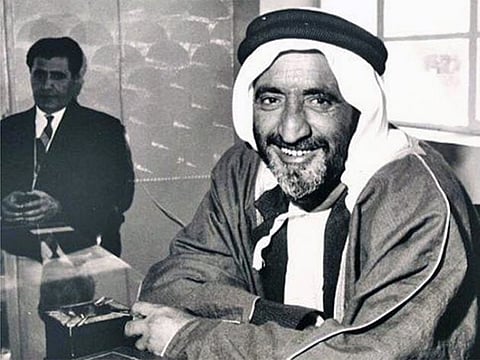Sheikh Rashid Bin Saeed Al Maktoum: The Engineer and Architect of Dubai
Sheikh Mohammed remembers his father Sheikh Rashid on his 29th death anniversary

Dubai: “Many hearts were broken as they could not believe they had lost a father.”
This was how His Highness Sheikh Mohammed Bin Rashid Al Maktoum, Vice-President and Prime Minister of the UAE and Ruler of Dubai, remembered his father, Sheikh Rashid on his 29th death anniversary.
Sheikh Mohammed tweeted: “On October 7, 1990, Shaikh Rashid Bin Saeed Al Maktoum departed our world. Dubai lost its founding father and architect. Many hearts were broken as they could not believe they had lost a father.”
“The most painful moment in one’s life is losing his father. It makes him an orphan. The father is the reason for one’s existence and life and the reason behind his success and the reason your country exists.”
Who was Sheikh Rashid?
Sheikh Rashid ruled Dubai from 1958 till 1990, he was the 8th ruler of Dubai after his father Sheikh Saeed.
Born in 1912, he ruled Dubai for 32 years from 1958 till his death in 1990. He paased away at the age of 78.
He was known for his simplicity and being down to earth. He was always close to the people of the emirate, and his council was open every afternoon to his people.
The Family man
According to Sheikh Mohamad in his book Qissati, his father was “a combination of pride, compassion and power.”
Sheikh Rashid Al Maktoum was married to Sheikha Latifa bint Hamdan Al Nahyan. They had four sons and four daughters.
Maktoum, Hamdan, Mohammed, Ahmed, Maryam, Fatima, Hessa and Maitha.
According to Sheikh Mohammed, his father’s health started to deteriorate after the death of his mother Shaikha Latifa in May 1983 .“As if two souls were separated. She took with her something from him.”
How did the Ruler of Dubai lead the development march?
“Towards the end of his life, what gave him utmost happiness was to sit in one of Zabeel Palace’s balconies. To see Dubai, his developing city which he built with his sweat, engineered with his ideas, and sacrificed his days and nights for it.”
During his reign, the emirate witnessed major developments involving all sectors, his vision was the engine which led to what Dubai is today.
He was endowed with a foresight which most people of his time found incomprehensible.
His vision was to diversify the economy of Dubai, he saw that oil could not be depended on, a commodity that will end one day. His famous line was: “My grandfather rode a camel, my father rode a camel, I drive a Mercedes, my son drives a Land Rover, his son will drive a Land Rover, but his son will ride a camel." Sheikh Rashid was referring to the day when oil will finish.
So he started to develop an economy that would rely on other sectors, he made Dubai a commercial hub. He worked on a number of major infrastructure projects to promote Dubai as a regional hub for trade starting with Port Rashid in 1972, followed by Al Shindagha Tunnel in 1975, Jebel Ali Port in 1979, Dubai World Trade Centre in 1978 and Dubai Drydocks in 1983.
Old timers recall that the waiting time for ships to berth was sometimes as long as six weeks, before 1970. Businessmen who wanted fast deliveries resorted to hiring lighter craft to unload cargo in the high seas and then bring them into the creek for delivery. Some went to the extent of leasing smaller seagoing vessels which could enter the creek and discharge directly.
Major dates in Sheikh Rashid rule
Shaikh Rashid watched this and realized that it was time to embark on an even bigger venture. And Mina Jebel Ali came into being. When oil was discovered in commercial quantities in Dubai in 1966, oil revenues started flowing into the treasury, he was able to use oil revenues to escalate Dubai's growth to new heights. He made sure that changes would take place in the fields of education, health, and social security. He ordered that hospitals and clinics to be built around the city. He founded the basic institutions of a state like the municipality, land development offices and civil aviation.
Dubai was the first in the Gulf to set up a Chamber of Commerce - an institution which is known far and wide for its efficient and quick service to its members. Dubai got its airport under his rule and all the power and water stations.
Every modern amenity - schools, hospitals, post offices, supermarkets, hotels and services of every description sprang up at a commendable speed - and the city's population grew with the influx of expatriates bringing their skills in trade and other professions to live and work under the wise and liberal rule of Sheikh Rashid.
The Statesman
Sheikh Rashid along with Sheikh Zayed bin Sultan Al Nahyan worked hand in hand to achieve the dream – the unity of the emirates. The first initiative was in 1968 when ‘Rashid welcomed the invitation of Zayed’, and the two leaders met in Saih Al Sadeera, an area between Abu Dhabi and Dubai. Announcing the unity of the two emirates was a jump start to the unity of the rest of the emirates. The dream became a reality in 1971 with the announcement of the United Arab Emirates. Sheikh Rashid became the Vice President of the UAE in 1971 and the Prime Minister in 1979.
Sign up for the Daily Briefing
Get the latest news and updates straight to your inbox


